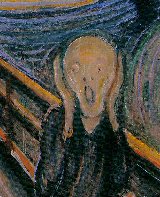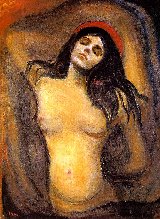
The Scream - 1893 A history of high-profile art thefts:

Madonna - 1894-5 |
Stolen Munch Paintings Recovered DOUG MELLGREN, ASSOCIATED PRESS - September 1st, 2006. OSLO, Norway — Art lovers had feared the worst. Brazen thieves had made off with the Edvard Munch masterpieces "The Scream" and "Madonna," and there was speculation that the gang burned the paintings to escape the police search. On Thursday, police relieved those worries by recovering the national artistic treasures — just over two years after masked gunmen grabbed the paintings in front of stunned visitors at an Oslo museum and disappeared. "I saw the paintings myself today, and there was far from the damage that could have been feared," said Iver Stensrud, the police inspector who headed the investigation since the paintings were taken by masked gunmen who raided the Munch Museum on Aug. 22, 2004. Experts from the Munch Museum confirmed that the paintings, still shielded from the public and the news media, were the real thing. "I am almost crying from happiness," said Gro Balas, chairwoman of the Munch Museum board. Norwegians were shocked when two or three thieves in black masks entered the museum and threatened an employee with a handgun, then wrenched the two paintings off the wall and fled. Many museumgoers panicked, thinking they were being attacked by terrorists. Many people initially thought the paintings might be offered for ransom. Art experts said it would be nearly impossible to sell such famous pieces of art, although some people speculated an immensely rich, unscrupulous art lover might be a willing buyer. Then at a trial this year for three men charged with minor roles in the heist, prosecutors suggested the robbery was staged to distract police from the hunt for a gang behind a commando-style bank robbery four months earlier that killed a police officer and netted $9 million. Norwegian news media reported recently that the convicted mastermind in the bank heist, David Toska, had made a deal for milder terms in a 21-year prison sentence in exchange for the return of the paintings. Police declined comment. The two paintings were on an FBI list last fall on the top 10 art thefts around the globe. Among still missing works are three Rembrandts, a Vermeer, a Manet and five Degas taken from Boston's Isabella Steward Gardner Museum in 1990 and a Cezanne stolen from England's Ashmolean Museum in 1999. "The Scream" is probably the best known work in Munch's emotionally charged style, which was a major influence in the birth of the Expressionist movement. In his four versions of the painting, a waif-like figure is apparently screaming or hearing a scream. The image has become a modern icon of human anxiety. "The Scream" and "Madonna" were part of the artist's ``Frieze of Life" series, focusing on sickness, death, anxiety and love. Munch died in 1944 at the age of 80. Hans-Martin Frydenberg Flaaten, whose University of Oslo master's thesis was on "The Scream," said the simple fact that the image has been used worldwide for everything from masks to blowup dolls to election campaign posters underscores its impact. "There is so much appeal. The shock effect. An almost scary feeling of looking at it," Flaaten said. "If you look at children who see it, they are also fascinated.'' He said part of the fascination with Munch's works, not just ``The Scream," is they can look as if he just slapped paint on a canvas, but closer study reveals carefully considered detail. "Getting it back was wonderful. I was worried when it took two years," Flaaten. Historian Sue Prideaux, whose "Edvard Munch: Behind the Scream," came out last year, applauded the recovery. "The Scream is one of the universal images that so vividly expressed all the uncertaintities of modern man," Prideaux said. Stensrud, the police inspector, said authorities believed the paintings had been in Norway the whole time. But he was cagey at a news conference in Oslo about how the paintings were recovered, saying only that "the pictures came into our hands this afternoon after a successful police action.'' He did say no reward was paid, even though the City of Oslo, which owns the paintings, offered 2 million kroner, or about $294,000, for their return. He also said three men convicted this year for roles in the theft did not provide any help. "We built this stone for stone," Stensrud said of the investigation. "This is a joyous day for the police, and for Norway.'' No new arrests were reported. Three Norwegian men sentenced to prison in May were convicted of participating in the theft plot, but police said the masked gunmen remain at large. Petter Tharaldsen, 34, was convicted of driving the getaway car and sentenced to eight years in prison. Bjoern Hoen, 37, was sentenced to seven years in prison, and Petter Rosenvinge, 38, to four years for providing and preparing the getaway car. The theft of "The Scream" was the second time in a decade that a version of Munch's iconic painting was stolen. One of the other versions was taken from Oslo's National Gallery in February 1994, but recovered three months later.
|
|